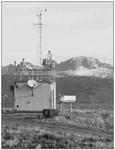|
Sublette Examiner Volume 8, Number 31 - October 23, 2008 brought to you online by Pinedale Online
by Derek Farr It was a chilly morning. The sun crested the Wind River Mountains to reveal the delicate wisps of stray cirrus clouds far above the Upper Green River Valley (UGRV). The high-level clouds shined orange in the early morning light. They contrasted against a deep-blue sky. Just above the horizon, a thin layer of brown haze hung over the New Fork and Green River valleys. Below the haze, a large stand of gas rigs bustled with activity. Ted Porwoll, Forest Service air quality technician, was hard at work. On a bluff above the New Fork Valley, Porwoll was calibrating equipment at the Boulder monitoring station near Paradise Road. The $250,000 site is notorious. Last winter the site recorded ozone levels of 122 parts per billion (ppb) in an eight-hour average, well in excess of government standards. Surrounded by sophisticated monitoring equipment, Porwoll sipped on a mug of coffee in the site’s climate-controlled shed. “The information we’re collecting here can be used (for government regulations),” he said. “There’s a lot of stuff going on here that’s precedent-setting.” Of all the instruments that adorn the small shed, nothing garners Sublette County residents’ attention more than the ozone monitor. The ozone monitor is paired with another machine that produces ozone in exact quantities. The second machine is used to test the monitor. In prearranged sequences, the ozone-producing machine extracts an exact amount of the gas and feeds it to the monitor. Site operators compare the monitor’s reading against the amount of ozone produced to test its accuracy. The entire site uses redundancy to ensure accurate measurements. Any data that deviates from precision is excluded. But it doesn’t require a precision device to notice the thin brown cloud that hangs over the valley below. “If it’s black, it tends to be particulate matter,” Department of Environmental Quality (DEQ ) staff engineer Jennifer Frazier said. “The brown is generally NOx.” Frazier is the enforcement arm of the DEQ. She monitors gas producers in the Jonah for air-quality violations. NOx is the acronym for nitrogen oxide, created by burning fossil fuels. Frazier and Porwoll pointed to the southwest. They explained that the NOx tend to gather at the confluence of the Green and the New Fork rivers. Porwoll said on bad days the NOx “backs up” toward Boulder Lake. It is not possible to scientifically proclaim that the brown cloud originates in the gas fields because there isn’t enough data – yet. While it seems rather unlikely standing at the Boulder Monitoring station, it is possible the pollution is traveling northeast from Salt Lake City or Big Piney. To conclusively determine its origins, monitors need to follow the pollution’s life cycle from tailpipe to brown cloud. “That’s exactly what we are trying to do with our emissions inventory and our modeling,” Frazier said. Unique complexity It’s not easy. Ozone and air quality in the UGRV is a combination of several complex subjects including organic chemistry, meteorology and gas-field production. Frazier, who has a master’s degree in civil engineering and 10 years’ experience in air quality, admits even she can be overwhelmed by the topic. “It is sophisticated stuff we are doing here,” she said. Ozone is formed from a fantastically complex set of chemical reactions between NOx and Volatile Organic Compounds (VOC). While NOx are emitted out of the exhaust pipes of cars, trucks and drill rigs, VOC are best described as the fumes from petroleum products. Frazier uses a $75,000 infrared camera to see the almostinvisible VOC. The camera uses heat signatures to see the fumes. During a training class in Texas, Frazier shot footage of a man gassing his car. She held up a portable media player that clearly showed black mists emanating from the gas nozzle. A surprising amount of VOC drifted from the nozzle. But before VOC and NOx start producing ozone, they require a few more ingredients and in the New Fork River Valley, the ingredients come together perfectly during the winter. The ozone requires an inversion (a layer of dense, stagnant cold air trapped near the ground) and ultraviolet light from the sun. But the sun isn’t enough. Ozone requires an uninterrupted layer of snow to reflect the sunlight and “cook” the NOx and VOC. “The reaction can happen over and over again with the same stuff,” Porwoll said. It is the UGRV’s unique ingredients and conditions that produce such precedentsetting air-quality issues. The UGRV is one of the only places in the world that has a problem with wintertime ozone. Frazier and VOC While the source of NOx is obvious, VOC are less overt. NOx come from internal combustion engines. But it is the gas-field production units that produce the VOC. After a well is completed, it produces gas, water and condensate (a liquid similar to diesel fuel). When the trifecta comes out of the ground it proceeds to a production unit where the water, condensate and gas are separated. From there the gas goes into a glycol dehydration unit. The gas passes through glycol heated to 375 degrees. This process squeezes out almost all the moisture from the gas, but it also produces VOC. The VOC (a combination of benzene, ethylbenzene, xylene and toluene) aren’t allowed to escape into the atmosphere. Instead, they are burned in a combustion unit. The combustion units destroy 95 percent of the VOC, turning them into more benign substances of carbon dioxide and water. VOC are also present in the condensate. After the condensate is separated from the natural gas, it is stored in large tanks. Inside the condensate tanks, large amounts of VOC mist off of the liquid like fumes from gasoline. Those VOC are piped to a second combustion facility that destroys 98 percent of the VOC. Any failure in those systems, and the VOC is vented directly into the air. According to Frazier, the dehydrators and collection units are the front lines of the ozone battle. And it is Frazier’s job to inspect those facilities. The battle zone Wearing a fire-resistant suit, a hard hat and a respirator, Frazier uses sensory observations to detect violations. Because it isn’t written into regulation, her $75,000 infrared camera is just a screening device. When she finds a violation, Frazier writes a report detailing the violation. The report is submitted to her supervisors who review it and pass it to DEQ Air Quality Division Administrator David Finley. Finley must approve the report before it moves on to DEQ Director John Corra’s desk. It requires Corra’s signature before it becomes a notice of violation (NOV). At that point the company has 10 days to contact the DEQ before the NOV is referred to the Attorney General. “It’s an opportunity for a company to come in and discuss resolution of the violation,” DEQ Air Quality Division Compliance Program Manger Robert Gill said. At that point, the NOV reaches a settlement discussion stage. Gill said that stage is quite lengthy. “Some settlements can be very difficult problems to resolve,” he said. “There are generally multiple meetings where the company has to go back and find information about what’s occurring.” The resolution stage takes place behind closed doors. In fact the resolution stage is so clandestine, should the case reach District Court, comments made during the resolution stage are not admissible in court. According to Gill, most cases don’t make it to court. When a resolution is reached, its stipulations become public record. Most resolutions involve monetary recovery and mitigation. NOVs and their resolutions are available on the DEQ Web site at http://deq.state.wy.us/out/AQenforcementactions.htm. EnCana is one of the most common company names on the violation list. One EnCana violation dated Jan. 24, 2007, states that Frazier “observed visible emissions from both dehydration units. Both valves were observed open and continuously venting vapors to the atmosphere. It was also noted the piping from the dehydration units to the combustor was missing.” This notice, as with other EnCana NOVs, has not been resolved. Four EnCana 2007 NOVs have a status of “settlement pending,” while eight have no status at all. BP, Ultra Resources, Anschutz, and Devon Energy Production also have NOVs on the Web site. While Frazier acknowledges she has submitted many unflattering reports against the gas companies, she says much is being done. “There were a lot of violations years ago, but since then the companies have really got their act together,” she said. “There has been a lot of innovation.” She said Wyoming’s air-quality standards are much more advanced than other states where VOC aren’t as tightly monitored. With new equipment and better training, Frazier said the gas companies have dramatically reduced their VOC emissions. One major improvement is the construction of central gathering facilities. Instead of many production sites producing gas and collecting condensate, the companies are building pipelines to deliver materials directly from the well site to a single, large central facility. That change should reduce VOC further, Frazier said. In addition, the pipelines will reduce NOx-producing truck traffic. “These companies are pushing the envelope of emission reduction,” she said. The air will decide. Standing at the site of the yet-to-be=constructed Pinedale Air Monitoring Station near Pine Creek on North Jackson Ave., Frazier smiles at the thought of a winter without ozone exceedances. But she knows the time is the test. She hoped this March a strong inversion will set up over the UGRV and an uninterrupted snow cover will reflect the sun’s brilliant rays back into a wide-open sky. If those conditions are met and the air monitor stations in Boulder and Pinedale report nominal ozone values, Frazier will know the work of hundreds of scientists, engineers, monitors and innovators is paying off. Real-time DEQ Air Quality Monitor data is available at www.wyvisnet.com. Photo credits: Derek Farr, Derek Farr See The Archives for past articles. Copyright © 2002-2008 Sublette Examiner All rights reserved. Reproduction by any means must have permission of the Publisher. Sublette Examiner, PO Box 1539, Pinedale, WY 82941 Phone 307-367-3203 examiner@wyoming.com |


